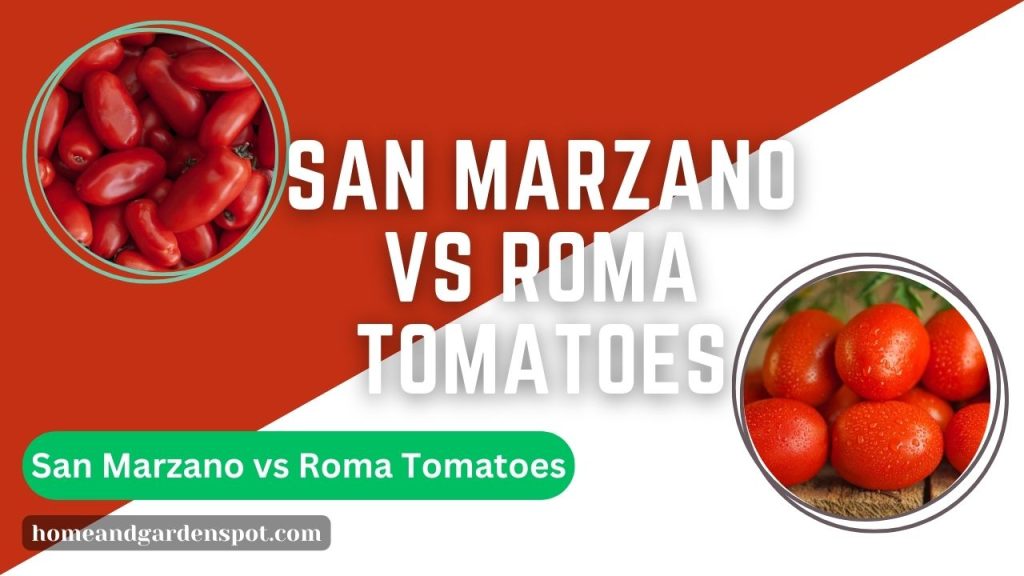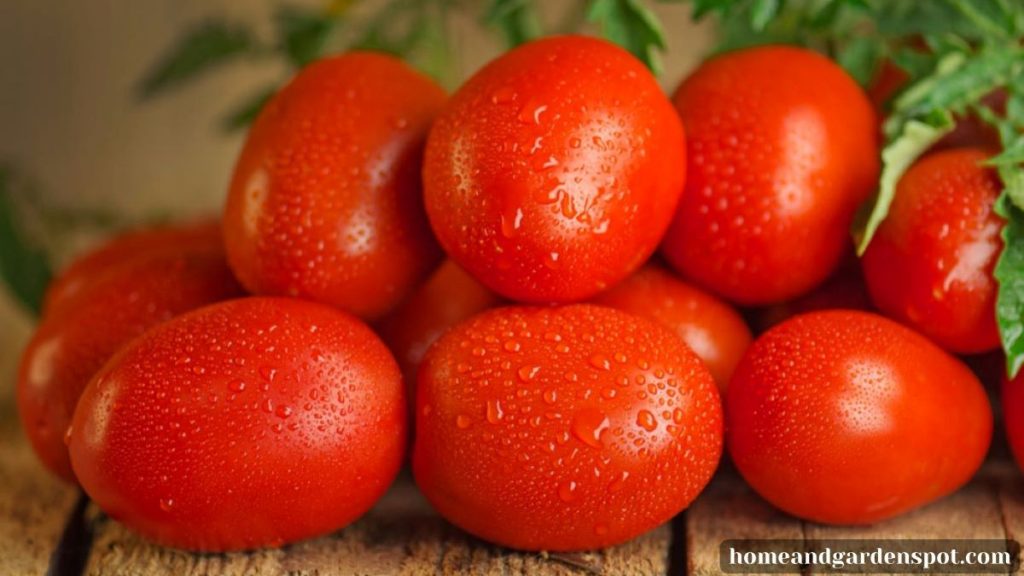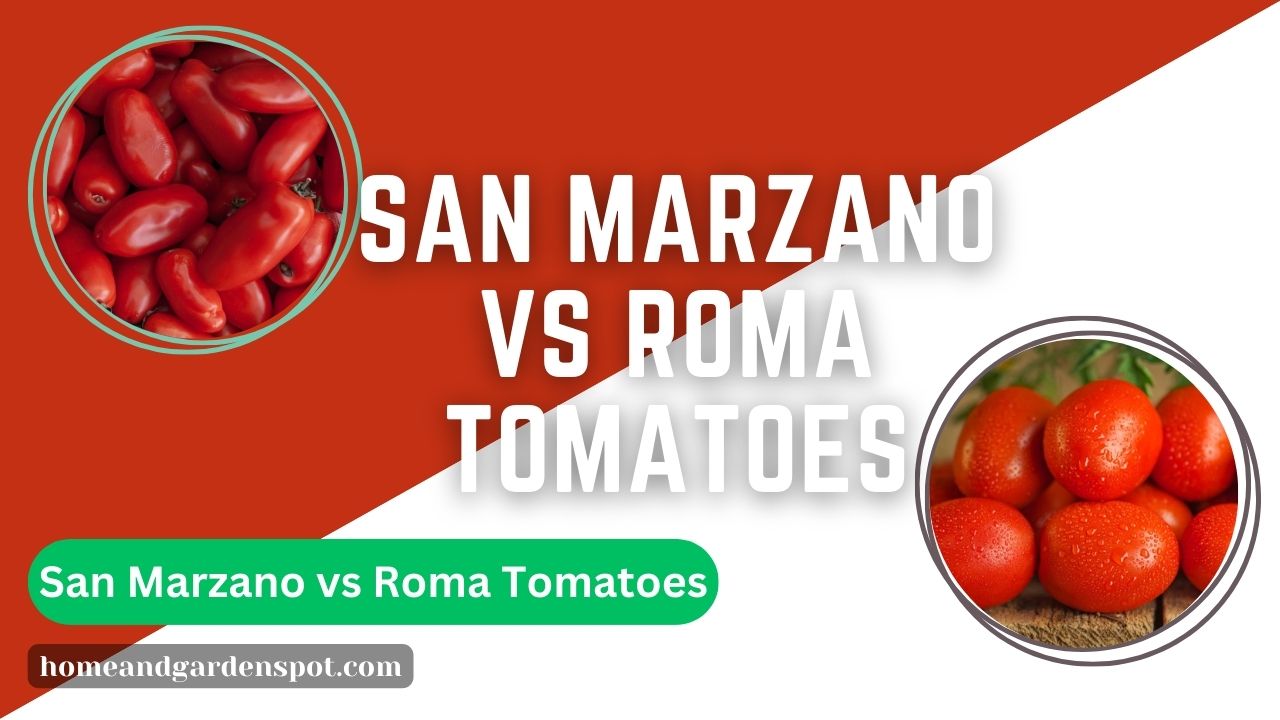If you love cooking with tomatoes, you may have wondered about the differences between San Marzano and Roma tomatoes, especially if you want to plant them.
These two varieties are often used interchangeably in recipes, but they have distinct characteristics that make them suitable for different dishes.
In this blog post, I will compare and contrast San Marzano and Roma tomatoes. I will also give you some tips on choosing between them before planting.

How Do San Marzano and Roma Tomatoes Differ?
Roma and San Marzano tomatoes are both types of low-moisture plum tomatoes, yet they have their differences.
San Marzano tomatoes have a longer and narrower shape than Roma tomatoes, which have a shorter and wider shape. They also have a deeper red color than Roma tomatoes, which have a brighter red color.
This is because San Marzano tomatoes have more lycopene, a pigment that gives tomatoes their red color and has antioxidant properties.
Let’s see how they differ in appearance, flavor, culinary uses, availability, and price.
1. Appearance
A difference is in their skin. San Marzano tomatoes have a thicker skin than Roma tomatoes, which makes them easier to peel when cooked.
However, some people may prefer the smoother skin of Roma tomatoes for eating raw or making salads.
2. Flavor and Texture
Another difference between San Marzano and Roma tomatoes is their flavor and texture. San Marzano tomatoes have a sweeter and tangier flavor than Roma tomatoes, which have a milder and slightly bitter flavor.
San Marzano tomatoes have more sugar and less acid than Roma tomatoes.
San Marzano tomatoes also have a firmer and meatier texture than Roma tomatoes, which have a softer and watery texture.
This is because San Marzano tomatoes have less water content and more solid content than Roma tomatoes.
3. Culinary Uses
Another difference between San Marzano and Roma tomatoes is their culinary uses.
San Marzano tomatoes are ideal for making sauces, especially pizza sauce because they have a rich and concentrated flavor and a thick and smooth consistency.
They also retain their shape well when cooked, which adds to their visual appeal.
Roma tomatoes are also good for making sauces but have a lighter and thinner consistency than San Marzano tomatoes.
They also tend to break down more when cooked, which makes them less suitable for dishes that require whole or chunky tomatoes.
However, Roma tomatoes are great for making soups, stews, and salsa because they have a high water content and a mild flavor that blends well with other ingredients.

4. Availability and Price
Another difference between San Marzano and Roma tomatoes is their availability and price.
San Marzano tomatoes are more seasonal and less common than Roma tomatoes, making them harder to find and more expensive.
San Marzano tomatoes are usually sold in specialty stores or online, costing up to $5 per pound.
Roma tomatoes are more widely available and cheaper than San Marzano tomatoes, making them easier to find and more affordable.
Roma tomatoes are usually sold in supermarkets or farmers’ markets, costing as low as $1 per pound.
How are San Marzano and Roma Tomatoes Similar?
Despite their differences, San Marzano and Roma tomatoes also have some similarities that make them both great choices for cooking with tomatoes. Here are some of the similarities between San Marzano and Roma tomatoes:
1. Tomato Family Classification
San Marzano and Roma tomatoes belong to the same tomato family classification: the plum tomato or paste tomato group.
This group includes tomatoes with high solid and low water content, making them ideal for processing into sauces, pastes, or ketchup.
Plum tomatoes have fewer seeds and less juice than other tomato groups, such as cherry tomatoes or beefsteak tomatoes.
2. Versatility in Cooking
San Marzano and Roma tomatoes are versatile in cooking, which means they can be used for various dishes and cuisines.
Both types of tomatoes can be cooked in different ways, such as roasting, baking, grilling, sautéing, or boiling.
They can also be eaten raw or added to salads, sandwiches, or wraps. Both types of tomatoes can enhance any dish’s flavor, color, and texture.
3. Popular Choice for Canning and Sauces
San Marzano and Roma tomatoes are popular choices for canning and sauces, meaning they can be preserved for longer periods and used throughout the year.
Both types of tomatoes have a high solid content and a low water content, which makes them suitable for canning without losing their quality or flavor. They also have thick skin that protects them from bruising or spoiling.
Both types of tomatoes can be canned whole, diced, crushed, or pureed. They can also be made into sauces, pastes, or ketchup.
How to Choose Between San Marzano and Roma Tomatoes?
Now that we know the differences and similarities between San Marzano and Roma tomatoes, how do we choose?
Here are some factors to consider when choosing between San Marzano and Roma tomatoes:
1. Personal Preferences
One of the most important factors to consider when choosing between San Marzano and Roma tomatoes is your preferences.
Do you prefer a sweeter or a milder flavor? A firmer or a softer texture? A thicker or a thinner consistency? A deeper or a brighter color? A smoother or rougher skin? Depending on your taste buds and preferences, you may like one type of tomato more.
2. Cooking Applications
Another factor to consider when choosing between San Marzano and Roma tomatoes is your cooking applications.
What kind of dish are you making? What kind of sauce do you need? How do you want your tomatoes to look and feel?
Depending on your recipe and cooking needs, you may need one type of tomato more.
For example, if you make pizza sauce, you should use San Marzano tomatoes because they have a richer and more concentrated flavor and a thicker and smoother consistency.
They also retain their shape well when cooked, which adds to their visual appeal.
However, if you are making soup or salsa, you may want to use Roma tomatoes because they have a lighter and thinner consistency and a mild flavor that blends well with other ingredients.
They also break down easily when cooked, which makes them less noticeable in the dish.
3. Availability and Budget
Another factor to consider when choosing between San Marzano and Roma tomatoes is your availability and budget.
How easy is it to find the type of tomato you want? How much are you willing to spend on it?
Depending on your location and resources, you may have more access to one type of tomato than the other.
For example, if you live in Europe or near an Italian specialty store, you may have more access to San Marzano tomatoes than in other parts of the world.
However, if you live in North America or near a supermarket or farmers’ market, you may have more access to Roma tomatoes than in other parts of the world.
Similarly, if you have a tight budget or want to save money, you may wish to use Roma tomatoes because they are cheaper and more affordable than San Marzano tomatoes.
However, suppose you have a flexible budget or want to splurge on quality. In that case, you may want to use San Marzano tomatoes because they are more expensive and flavorful than Roma tomatoes.
How to Plant and Grow Roma Tomatoes?
Roma tomatoes are a plum tomato ideal for making sauces, pastes, and ketchup. They have a mild and slightly bitter flavor, a soft and watery texture, and a bright red color.
They are easy to grow in pots or on the ground if they get enough sun, water, and fertilizer. Here are some steps to plant and grow Roma tomatoes:
1. Start With Healthy Seedlings Or Seeds
You can buy Roma tomato plants from a nursery or online or start your seeds indoors in a heated propagator from late winter to early spring.
2. Choose A Sunny And Sheltered Spot For Your Tomatoes
Roma tomatoes need at least 6 hours of full sun daily, ideally 8-10. They also need protection from strong winds and frost.
3. Prepare The Soil Or Potting Mix
Roma tomatoes prefer rich, well-drained, slightly acidic soil with a pH of 6.0 to 6.8. You can add organic matter, such as compost or manure, to improve the soil quality.
If growing in pots, use a large container (at least 5 gallons) with drainage holes and fill it with peat-free, multi-purpose compost.
4. Plant Your Roma Tomato Seedlings Or Seeds
Pinch the bottom leaves from your seedling, dig a small hole, and put ¾ of the plant inside the soil. When planting Roma tomatoes in a pot, planting seedlings at a deep level is advisable.
The correct depth will enable the roots to sprout up to the stem, giving the plant strong support.
If you are sowing seeds, plant them about ¼ inch deep and 2 inches apart. Space your plants about 2 feet apart if growing in the ground.
5. Support And Tie Your Plants As They Grow
Roma tomatoes are a semi-determinate or bushy type of tomato that doesn’t need much pruning, but they do need sturdy supports to prevent them from collapsing under the weight of the fruits.
You can use stakes, cages, or trellises to support your plants and tie them regularly with soft twine or cloth strips.
6. Water And Feed Your Plants Regularly
Roma tomatoes need consistent moisture to prevent cracking, blossom end rot, and nutrient deficiencies.
Water them deeply and evenly, preferably in the morning or evening, avoiding wetting the leaves. You can also mulch around the plants with straw or grass clippings to conserve moisture and suppress weeds.
Feed your plants with a specific tomato fertilizer every two weeks once they start to form fruits. Follow the directions on the label for the correct dosage.
7. Harvest Your Roma Tomatoes When They Are Ripe
Roma tomatoes usually take about 75 to 80 days from planting to harvest. You can tell they are ripe when they have a bright red color and are slightly soft.
Pick them gently by twisting them off the stem or using scissors or a knife. Enjoy them fresh, or use them for making sauces, soups, stews, salsa, or canning.
Related post: Roma Tomato vs. Regular Tomato
How to Plant and Grow San Marzano Tomatoes?
San Marzano tomatoes are a type of plum tomato that originated in Italy and are famous for their sweet and tangy flavor, firm and meaty texture, and thick and smooth consistency.
They are ideal for making sauces, pastes, and ketchup. They have a protected designation of origin (PDO) status in the European Union, which means that only tomatoes grown in a specific area of Italy can be labeled as San Marzano.
Here are some steps to plant and grow San Marzano tomatoes:
1. Start With Healthy Seeds Or Seedlings
You can buy San Marzano tomato plants from a nursery or online or start your seeds indoors in a heated propagator from late winter to early spring. You can also buy seeds from reputable sources that have the PDO certification.
2. Choose A Sunny And Sheltered Spot For Your Tomatoes
San Marzano tomatoes need at least 8 hours of full sun per day and protection from strong winds and frost. They also need rich, well-drained, slightly acidic soil with a pH of 6.0 to 7.0.
You can add organic matter, such as compost or manure, to improve the soil quality. If growing in pots, use a large container (at least 5 gallons) with drainage holes and fill it with peat-free, multi-purpose compost.
3. Plant Your San Marzano Tomato Seedlings Or Seeds
Plant the seedlings deeply, burying at least two-thirds of the stem underground.
This will help them develop strong roots and prevent diseases. Space your plants about 3 feet apart if growing in the ground. If you are sowing seeds, plant them about ¼ inch deep and 2 inches apart.
Thin out the seedlings when they have two true leaves, leaving only the strongest ones.
4. Support And Tie Your Plants As They Grow
San Marzano tomatoes are an indeterminate or vining type of tomato that needs sturdy supports to prevent them from collapsing under the weight of the fruits.
You can use stakes, cages, or trellises to support your plants and tie them regularly with soft twine or cloth strips.
You must also prune your plants by removing the suckers or side shoots between the main stem and the branches.
This will help them focus their energy on producing fruits rather than foliage.
5. Water And Feed Your Plants Regularly
San Marzano tomatoes need consistent moisture to prevent cracking, blossom end rot, and nutrient deficiencies.
Water them deeply and evenly, preferably in the morning or evening, avoiding wetting the leaves. You can also mulch around the plants with straw or grass clippings to conserve moisture and suppress weeds.
Feed your plants with a specific tomato fertilizer every two weeks once they start to form fruits. Follow the directions on the label for the correct dosage.
6. Harvest Your San Marzano Tomatoes When They Are Ripe
San Marzano tomatoes usually take about 75 to 90 days from planting to harvest.
You can tell they are ripe when they have a deep red color and are slightly soft.
Pick them gently by twisting them off the stem or using scissors or a knife. Enjoy them fresh, or use them for making sauces, pastes, or ketchup.
Conclusion
San Marzano and Roma tomatoes are two types of plum tomatoes with different characteristics that make them suitable for different dishes.
San Marzano tomatoes are sweeter, tangier, firmer, meatier, thicker, smoother, deeper, and more expensive than Roma tomatoes.
Roma tomatoes are milder, slightly bitter, softer, watery, thinner, rougher, brighter, and cheaper than San Marzano tomatoes.
However, both types of tomatoes also have some similarities that make them both great choices for cooking with tomatoes.
Both types of tomatoes belong to the plum tomato group, are versatile in cooking, and are popular for canning and sauces.

Leave a Reply